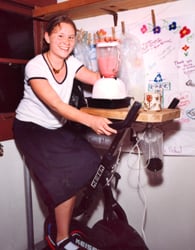
The mission of the Campus Center for Appropriate Technology (CCAT) at Cal Poly Humboldt (HSU) is to promote the use of appropriate technology through demonstration and education. A popular element of these demonstrations is the decades old use of human and pedal power to complete everyday tasks, such as clothes washing or watching TV. The CCAT Pedal Powered Blender was first designed and built by Bart Orlando with the help of HSU student Saremy Graves in 1997. Since then, it has been a favorite feature of many campus and community events. It has even been featured front and center on the cover of the San Francisco Chronicle. The blender was built by modifying an old exercise bike; the flywheel of the bike turns a skateboard wheel, which is attached to a driveshaft connected to the blender. The Pedal Powered Blender is used to demonstrate the energy needed to power a blender while getting exercise and making a refreshing drink or smoothie.
Designed and Built for CCAT by Bart Orlando
Opportunity Definition[edit | edit source]
The Pedal Powered Blender received a makeover in 2004, when it was updated with a new larger crank wheel, a new mounting plate, handlebars, and a new paint job. Since then, the bike has seen an additional six years of frequent use, and it is time for another overhaul. Robert Camacho and Eric Recchia will complete the overhaul for their Engineering 305 class project. One of the pillow block bearings will need to be replaced, and several proposed upgrades include a new paint job and blender mounting board and fixture.
Gallery[edit | edit source]
-
The CCAT pedal powered electric blender was designed and built by Bart Orlando. CCAT asked Bart to build a pedal powered blender which they could use at a reception follwing the inauguration ceremony for HSU president Roland Richmond in 2003. It is also used by a variety of campus organizations for their fund raising activities. It is currently on display at CCAT's temporary office building.
-
A fan belt is wrapped around the flywheel of an exercise bike and the pulley of high voltage, low rpm permanent magnet dc generator. 110v blenders and some other low power ac appliances can be powered provided they are built using universal motors which run on ac or dc. The next stage of development of this project is to mount the generator directly to the frame of the exercise bike via a gravity tensioned swing arm. This will eliminate the need for the heavy wooden pedistle upon which the generator is currently mounted. The electrical wiring should be brought up to code. Transparent lexan-polycarbonate finger gaurds should be installed to prevent children from catching their figures between the fanbelt, pulley and flywheel. Lastly, large caster wheels should then be mounted to the base of the exercise bike's frame so that the devise can be moved easily. Because of the redundant nature of an exercise bike as compared to a bicycle that is used for transportation, a system should be designed that incorporates a blender, powered by a generator mounted on a bicycle that tows an ice-box trailer.
-
CCAT member Eric holds up a part that needs to be fixed/replaced for the pedal electric blender.
-
The cutting board on the right replaced the cutting board on the left.
-
CCAT member Eric holds up a part that needs to be fixed/replaced for the pedal electric blender. It needs new bearings and CCAT is wants to design a new design for the drive shaft/train. They use a skateboard wheel for friction interface.
-
The cutting board on the right replaced the cutting board on the left.
-
A skateboard wheel is used for friction interface.
-
The last major update on the bike was in 2004 when they added handlebars and larger fly wheels and bearings. It currently is not working.





